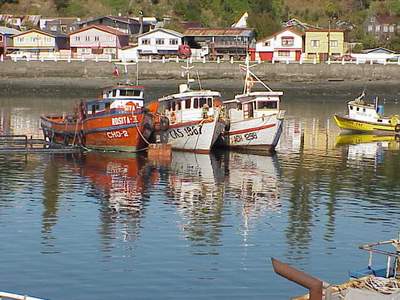 Ancud:
Ancud: It is located 87 kilometers south of Puerto Montt, in the city of Ancud, you can visit:
The Port and the Coastal, the Regional Museum of Ancud "Museoazul", the Cathedral, the San Francisco Church, the Gulf Quetalmahue, Fort San Antonio, Fort Powder, the Wellness Center of gravel, Cerro Mirador Huaihuén allowing a broad view of the city, the Canal de Chacao, islet Pigs, Corona Light, with its ruins of forts and batteries, the Rada Pudeto river with its bridges and large fishing port and yacht.
 Quemchi:
Quemchi: It is located 144 kilometers from Puerto Montt, Quemchi commune is located northeast of Isla Grande de Chiloe, among the most attractive places are:
Huite Estuary, River Auch, Beach Pinque, Queude Beach, Laguna Popet, Colo River, Aucar Island and the town of Quicaví.Desde Quicaví opens more expeditious route to Navigation Chauques Islands (cheniae, voigas, and Añihue) and Butachauques Islands (Metahue, Aulin, San Jose, Coneb, Maluco, Nayahue) and Tac Islands, with its wonderful inland sea, between one to two hours of sailing, where contact with nature and marine resources abundance become part of each hamlet.
The main access is along Route 5 at 40 km from Ancud, on the crossroads Degan and enter through a modern paved road at 23 km, which opens the door to a thousand landscapes and especially its internal sea where highlighted in its Mechuque sector as insular localities, including Metahue and Tac.
 Dalcahue:
Dalcahue: It is located 152 kilometers from Puerto Montt in Dalcahue can visit the Church of Dalcahue, Costanera There is Dalcahue Cultural Center, comprising a library, and the interesting Ethnographic Historical Museum, the Crafts Fair, the village of San Juan, the Waterfall Village Tocoihue and Tanaún.
 Quinchao:
Quinchao: It is located 173 kilometers from Puerto Montt in Quinchao visit, the viewpoints of La Paloma, Putique, Quinchao Achao Church, museums of the evangelization of Achao, Exhibition of photographs, Chaulinec Islands Group, Group Quenac islands, Lin Lil Island, the Island Funeral Services, Church of Quinchao Stone Achao the lookout.
 Chonchi:
Chonchi: It is located 187 kilometers from Puerto Montt in Chonchi visit, the urban area, the San Carlos de Borromeo Parish, the Chapel of Vilupulli, the cemetery, the Museum of Traditions.
 Queilen:
Queilen: It is located 230 kilometers from Puerto Montt, is tucked away off the mouth of Estero de Compu long, ending in a long beautiful sandy lace, which intersects the channel Queilen and the Gulf of Corcovado.
In Queilen can visit the "Shelter for sailors, beaches and Lelbun Queilén, Aituy village and agony, the Estero Paildad, Acui Island, Laguna Pio-Pio, Tranqui Island.
 Quellón:
Quellón: It is located 230 kilometers is located 251 kilometers from Puerto Montt, a town of the Pan American Highway terminal with large industrial and fishing activity in Quellón visit, Auchac village, the port from Quellón Llauquil craft Fair, Ant Cuivier Inchin Museum (our past), the Municipal Museum, the village of Yaldad, Playa Chaiguao and Austral Islands.































